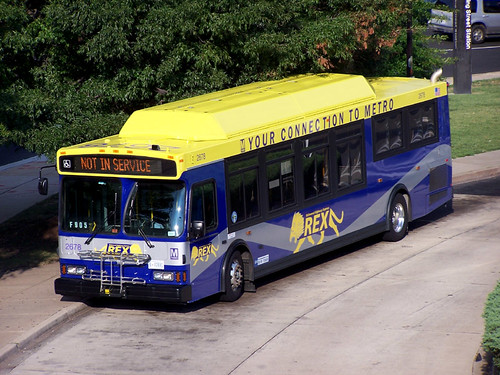Bus Rapid Transit Is Coming To Fairfax County, VA

“REX – Richmond Highway Express.” by BeyondDC is licensed under CC BY-NC-ND 2.0
Richmond Highway in Fairfax County is a major north-south connection from areas south of the beltway in eastern Fairfax County to Washington, DC, and despite the regularly heavy traffic and unreliable, infrequent bus service, no improvements have been made for decades. That is going to change as Fairfax County has begun designing a Bus Rapid Transit (BRT) line that will provide service along Richmond Highway. The service is expected to begin around the year 2030, although that is indefinite for the time being. The Washington, DC Metrorail system’s yellow line terminates at Huntington Station, which is exactly where Richmond Highway ends, so initially several options were considered including an extension of Metrorail along Richmond Highway. It was determined that the best short-term solution was building a BRT line, while the best long-term solution was extending Metrorail. The planning phase has dragged on for seven years now, although at this point the design has been mostly finalized, and it essentially includes a BRT line in the median of Richmond Highway from Huntington Metrorail Station to Fort Belvoir, which is 16 miles south on Richmond Highway. Other options for BRT were also considered, including a 27-mile long line extending south into Prince William’s County.
Currently the only public transit along Richmond Highway is the REX bus service (shown in the picture) operated by Metro which is infrequent and constantly stuck in traffic, so most travelers do not use it. The goal of the project is to not only enhance the experience of current riders but to attract new riders to public transit. For this reason, the BRT project is accompanied by several other projects in the area. Before the BRT is constructed, Richmond Highway will be widened to have one extra car lane in each direction and space for two BRT lanes in the middle. Additional space will be left along the edges of the road too because there will be wide sidewalks and two-direction bikeways on either side of the road. Though each of these projects is separately funded, they go hand in hand with each other as one big multimodal improvement project. A long term plan for the Richmond Highway corridor also includes a three mile extension of Metrorail service to serve an dense area that is a long walk from Richmond Highway. It is also possible that the BRT will be extended south to reach the originally planned 27 miles, though that is not included in current plans.
The design and branding of the BRT is underway, and Fairfax County is planning to either name it RHEX, The X, or The One. Each of these options has been considered and designs have been developed that would go along with them. The stops will have off-board fare collection and same level, all door boarding into three doored, articulated buses. Even the design of rain covers has been carefully considered, they will look like airplane wings to reflect the area’s unique architecture. Since the BRT will run in the center of the road in dedicated lanes, there should be no interference from car traffic, and even at intersections Transit Signal Priority (TSP) will be implemented to help keep the buses moving. Final details such as fares and exact frequencies of service have not yet been determined, but the design is essentially done. Construction will not actually begin for several years though, as the road has to be widened to give space for the BRT.
The Richmond Highway BRT is a great example of what a BRT should have: right of way at all times, high quality transit stations, frequent service, and multimodal connections; so the project as planned should greatly benefit those living in the area. The project itself is also a breakthrough for Fairfax County as the county’s leaders have shown reluctance in the past to invest in public transit, for example their reluctance to participate in the planned Duke Street BRT and their decision to build Metrorail in the cheapest locations possible. This is one of the first times Fairfax County has invested in such a major transit project. BRT does have its limits, though, as a bus will never be as good as rail transit sense it never will have complete right of way, however the Richmond Highway BRT should be able to make the same trips as the current REX service in 1/3 the scheduled time, so if that is not enough to get people out of their cars that nothing is.
Related Information:
https://www.fairfaxcounty.gov/transportation/richmond-hwy-brt
https://www.fairfaxcounty.gov/transportation/richmond-hwy-brt/background














